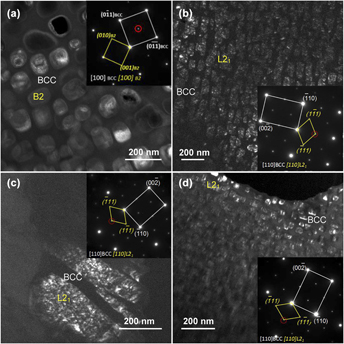Crossref Citations
This article has been cited by the following publications. This list is generated based on data provided by
Crossref.
Wang, Qing
Li, Zhen
Pang, Shujie
Li, Xiaona
Dong, Chuang
and
Liaw, Peter K.
2018.
Coherent Precipitation and Strengthening in Compositionally Complex Alloys: A Review.
Entropy,
Vol. 20,
Issue. 11,
p.
878.
Ma, Yue
Hao, Jiamiao
Wang, Qing
Zhang, Chuan
Li, Chunling
and
Dong, Chuang
2019.
Temperature-affected microstructural stability of coherent cuboidal B2 particles in precipitation-strengthened body-centered-cubic Al0.7CoCr2FeNi high-entropy alloy.
Journal of Materials Science,
Vol. 54,
Issue. 11,
p.
8696.
Jiang, Zhenfei
Chen, Weiping
Xia, Zebang
Xiong, Wei
and
Fu, Zhiqiang
2019.
Influence of synthesis method on microstructure and mechanical behavior of Co-free AlCrFeNi medium-entropy alloy.
Intermetallics,
Vol. 108,
Issue. ,
p.
45.
Shafiei, Ali
2021.
Design of Eutectic High Entropy Alloys in Al–Co–Cr–Fe–Ni System.
Metals and Materials International,
Vol. 27,
Issue. 1,
p.
127.
Onawale, Omoyemi Temitope
Cobbinah, Prince Valentine
Nzeukou, Rivel Armil
and
Matizamhuka, Wallace Rwisayi
2021.
Synthesis Route, Microstructural Evolution, and Mechanical Property Relationship of High-Entropy Alloys (HEAs): A Review.
Materials,
Vol. 14,
Issue. 11,
p.
3065.
Haas, S.
Manzoni, A.M.
Holzinger, M.
and
Glatzel, U.
2021.
Influence of high melting elements on microstructure, tensile strength and creep resistance of the compositionally complex alloy Al10Co25Cr8Fe15Ni36Ti6.
Materials Chemistry and Physics,
Vol. 274,
Issue. ,
p.
125163.
2022.
Mechanical Behavior of High-Entropy Alloys: Key Topics in Materials Science and Engineering.
p.
21.
Jin, Dong-Ming
Wang, Zhen-Hua
Li, Jin-Feng
Niu, Ben
and
Wang, Qing
2022.
Formation of coherent BCC/B2 microstructure and mechanical properties of Al–Ti–Zr–Nb–Ta–Cr/Mo light-weight refractory high-entropy alloys.
Rare Metals,
Vol. 41,
Issue. 8,
p.
2886.
Ju, Jiang
Shen, Zhao
Li, Jingjing
Xiao, Bo
Zhou, Yinghao
Li, Qian
Xiao, Weicheng
Li, Yifeng
Zeng, Xiaoqin
Wang, Jun
and
Yang, Tao
2023.
Unraveling the origin of the excellent high-temperature oxidation resistance of an AlCrFeNiTi complex concentrated alloy.
Corrosion Science,
Vol. 217,
Issue. ,
p.
111116.
Yan, Xiaolei
Ju, Jiang
Zuo, Lei
Ma, Ding
Hu, Jizhen
and
Zhang, Tao
2023.
Variation of BCC/B2 coherent microstructure and resultant improvement in strength of Al0.7CrxFe3−xCoNi high-entropy alloys.
Materials Characterization,
Vol. 203,
Issue. ,
p.
113129.
Wu, Mingyu
Sim, Rui Ken
He, Anqiang
Diao, Guijiang
Chen, Wengang
Chen, Daolun
and
Li, Dongyang
2023.
Mechanisms underlying the influence of Co and Ti on the microstructure, mechanical and wear properties of A2/B2 typed AlCrFeNi alloy.
Journal of Alloys and Compounds,
Vol. 968,
Issue. ,
p.
172070.
Ramírez – Ledesma, A.L.
Ruíz – Rodríguez, D.
Aburto – Perdomo, E.
López – Miranda, H.I.
and
Juárez – Islas, J.A.
2024.
Evaluation of critical temperatures of as-cast Co-based superalloys as a function of alloying elements and their effect on microstructure.
Materials Today Communications,
Vol. 41,
Issue. ,
p.
110515.
Cai, Xuan-Hong
Wang, Zhen-Hua
Niu, Ben
Li, Jin-Feng
and
Wang, Qing
2024.
Microstructural Evolutions and Mechanical Properties of Energetic Al1 (TiZrNbTaMoCr)15 High-Entropy Alloys.
Acta Metallurgica Sinica (English Letters),
Vol. 37,
Issue. 4,
p.
620.
Liu, Xuyang
Liu, Chenlu
Chen, Min
Bai, Chenguang
Zhang, Xuefeng
and
Wei, Liangxiao
2024.
Multicomponent Alloy of FeCoNiVTiAl with a Dual Core–Shell Structure and Cactus-Like Morphology for Aerospace Applications.
ACS Applied Nano Materials,
Vol. 7,
Issue. 14,
p.
16609.
Li, Xiaolong
Lu, Zheng
Gao, Shang
Li, Hui
Sun, Dingbo
Lin, Jiwei
and
Lu, Junqiang
2024.
Achieving superior compressive strength-ductility synergy in a novel ODS-CrFeNi/AlCrFeNi heterostructured high-entropy composite.
Materials Characterization,
Vol. 215,
Issue. ,
p.
114167.
Ju, Jiang
Zhao, Yimeng
Shen, Zhao
Chen, Kai
Xiao, Bo
Li, Xia
Qi, Dongqing
Zhao, Yilu
Wang, Jun
Sun, Baode
and
Yang, Tao
2024.
Insight into the oxidation behavior and excellent internal oxidation and nitridation resistance of Fe71.5-x(Ni, Cr, Ti)28.5Alx complex concentrated alloys by advanced characterization.
Corrosion Science,
Vol. 241,
Issue. ,
p.
112544.



